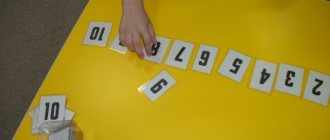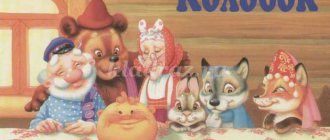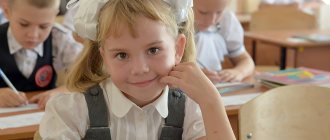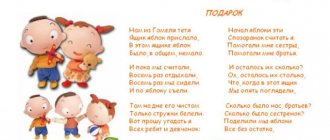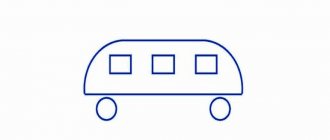The role of preschool educational institutions in the process of forming elementary mathematical concepts
Even in early childhood, babies encounter objects that differ in shape, color and quantity. At this age, the child’s basic elementary concepts and abilities begin to form.
The first toys resemble geometric shapes: cubes, construction sets, pyramids. The counting begins with mom’s questions: “Tell me, how old are you?” Parents teach children to name the shapes of toys, their size and quantity.
Through gaming activities, the ability to distinguish between different properties and features of objects is formed. The baby develops his first concept of mathematics, although he does not yet know or realize it. The consciousness of a child in early childhood is chaotic. Parents teach children to compare, group objects, and call them by their proper names.
Through visual and objective actions, they help the child remember what he hears based on objective images. By the age of three, a child can already group objects according to their external characteristics, color, and shape. So, for example, a child can put green toys away from red ones, select pencils from a pile of other objects and put them together, can put pyramid rings according to size, in order.
When engaging with objects through play activities, the child compares them. This is where the first acquaintance with mathematics begins.
By the age of four, children can easily count to five, and a little older to ten, but they may make mistakes in counting.
By the age of six, children begin to understand when numbers are increasing and when they are decreasing. That is why it is important to start systematic classes from kindergarten in order to increase the child’s mental perception.
In today's modern society, one of the requirements for preschool education is that children acquire mathematical knowledge and basic concepts in kindergarten.
In the course of their development, preschoolers receive their first basic understanding of mathematics. The available methods and means of forming elementary mathematical concepts are developed specifically for age categories, taking into account the gradual development of skills and abilities in preschoolers in this direction. Mathematics is an independent educational subject and is designed to develop intellectual abilities depending on the natural potential of preschool children. Its role in the development of elementary concepts in preschoolers is very great. During this type of activity, the child develops and develops cognitive and personal abilities.
During the learning process, through the means of mathematical classes, the child receives his first ideas about mathematical concepts. The goal of mathematics is the desire to educate preschoolers, with a future perspective, into highly qualified personnel.
To achieve the goal of education, in preschool institutions, when developing targeted programs and methods of education, domestic and foreign best practices should be taken into account, and recommendations for parents should be developed. It will be useful experience for educators if they exchange information and methods of raising children with other kindergartens and preschool institutions.
Mathematics is one of the few disciplines that covers different aspects of children's personality. In the process of forming elementary mathematical concepts and learning, all cognitive processes actively develop in preschoolers: speech, thinking, memory, perception, representation. This becomes effective if, when organizing classes, the frequency and sequence of development of cognitive processes in a child is taken into account, depending on the psychophysical development of each child.
If a child has not reached the age at which he is able to understand mathematical processes, then classes will not play any role for his consciousness. A child’s capabilities are determined by his psychology. In the modern world, innovative methods and means are increasingly included in preschool education programs.
Some preschool institutions are already using computer science lessons for preschoolers in their educational activities. The whole world is now connected with computer technology and it is gradually penetrating into kindergartens.
Mathematics is not necessarily a boring activity, as it might seem at first glance. To teach arithmetic, teachers play with children, come up with various counting rhymes, proverbs, sayings, and riddles. The child masters the first numerical concepts and forms.
There are also didactic forms and means of education that use visual aids, illustrations, and games. There are many approaches to teaching arithmetic and developing children's basic knowledge of mathematical concepts. Children are taught to count, shown the distinctive aspects of numbers: more, less, even, odd numbers.
To achieve results, various materials are used: counting sticks, natural materials, and they teach how to count and recognize money.
Children are taught to recognize geometric shapes: circle, square, triangle, etc. Children must also master measured quantities: meter, centimeter, kilogram, gram, etc. During classes, children are taught not only exponential arithmetic, but also to perform arithmetic operations in their heads. They learn to find and compare objects in everyday life, on the street and in nature. For example: three birch trees under the window.
Upon graduation from kindergarten, children should be ready for first grade, and also adapted to external independent life. After all, they will not always and everywhere walk hand in hand with their mother. Children will spend part of their time independently and rely on their skills - this is the process of development. In recent years, the concept of pre-mathematical preparation has been introduced into practice.
Preparing the child and his cognitive world for a mathematical way of thinking. Various ways of forming the cognitive sphere allow a child to be prepared for studying the subject of mathematics. When organizing classes, there is an impact on visual and logical thinking, memory, creative imagination, perception, and voluntary attention of the preschooler.
The goal of such education is to activate the preschooler’s thinking, the desire to overcome difficulties, and the need to solve various kinds of mental problems. Solving such problems in educating preschoolers is a very difficult job for a teacher and requires an integrated approach, and only systematic classes will allow for the timely mathematical development of preschool children.
The abilities of each child depend on his individual psychological characteristics. Mathematical abilities cannot be innate, since only anatomical and physiological characteristics of a person are innate. Mathematical abilities are a special type of ability; they depend on the integral quality of the mind and develop in the process of mathematical activity.
A person’s abilities can manifest themselves in various areas, and here, like everything else, mathematical abilities are revealed during the activities of a preschooler. The most favorable period for the development of abilities is considered to be preschool age.
Children in preschool age observe and imitate adults, they watch every action and listen carefully to what the teacher says and this is an important property. Children must be taught to act independently, to show and talk about their actions. Preschoolers should be encouraged to repeat after the teacher about the properties and qualities of objects. Games with children should contain mathematical activities.
Using comparative actions, children themselves must tell the teacher how this or that figure differs from another. If a child finds it difficult to answer, it means that his speech and perception are not sufficiently developed; if the child does not want to answer, then you should not put pressure on him or insist too much. Children become more aware of numbers if they start using them in everyday life, for example: please give me the second slipper. Children do not immediately recognize the numerical value - one, because it is not used in everyday speech. For them, the role of mathematical concepts in real life is inaccessible. Usually the kids say, “Give me the remote control, or a spoon, or some kind of toy.”
Awareness of the number one in children comes later than other numbers.
At the first stage of learning, children lack attentiveness and when listing the serial numbers of numbers, they often lose sight of the numbers: for example, they call them “1, 2, 4, 7.”
In older groups, it is worth teaching children about sets, dividing the set into groups and explaining to them the difference between a smaller and a larger group, as well as the equality of parts. Visually teach preschoolers the sequence of counting to ten and counting backwards. Teach children to count by touch and by ear within ten.
Learn to compare the number of objects in different groups, add and remove objects to a given number.
Children in preschool age are able to divide objects and name their parts, for example, dividing an apple into slices or a pie. Preschoolers should understand that a whole apple is larger than a slice or half an apple. Senior students must master and understand that the number 7 is more than six, but less than eight. By the end of the learning period, preschoolers should be able to perform simple mathematical operations.
Theory and methodology of conducting mathematics classes
Toddlers lack abstract thinking, but mathematics is accessible to children using actions and imaginative thinking. How to implement this in practice is described below.
How to teach your child mental math on your own
Geometry lesson notes
When teaching mathematics, the teacher needs to introduce children to abstract concepts in a fun way and teach them how to use them. An example of an activity with the help of which this problem can be solved in the middle and senior groups is given below.
The purpose of such a children's mathematics lesson is to give children basic knowledge of geometry. To increase interest in studying mathematics at 3-4 years old or at an older age, the environment for children’s research activities is recreated, parallels are drawn between the sphere of mathematical knowledge and real life.
Girl at the blackboard
When planning how to teach a child mathematics, it is necessary to ensure the solution of the following problems:
- Children are helped to understand that the essential features of figures do not depend on their size or specific spatial location.
- At the age of 4+, they are instilled with the ability to be mathematically vigilant. At the same time, they are taught to compare objects not only by their appearance, but also by their geometric shape. In particular, they learn to find objects in their immediate environment that are similar or different in geometric shape.
- Kids can learn to design a shape based on its description.
- They teach how to create thematic compositions of figures.
- At the age of 4-5, mathematical thinking abilities are taught.
- They instill the skills of competent logical thinking and teach how to correctly build logical reasoning.
- At 6-7 years old, the connection between abstract mathematical knowledge and productive activity is explained. The kids are explained how to use the knowledge gained in the lessons and apply it usefully in practical life.
The type of lesson is educational and research.
Preparation
To complete the tasks you will need the following materials:
- ball;
- phonogram with recorded music for physical education;
- set of geometric shapes;
- cards depicting the planets of the solar system;
- checkered sheets of paper;
- Every child needs a simple pencil.
For the lesson you will need the following: a computer, an interactive whiteboard and a projector.
It is necessary to carry out preliminary preparation for the lesson. For physical education, you will need to study basic movements in advance. Children, under the guidance of a teacher, will have to tactilely explore the prepared geometric shapes. It is recommended to provide viewing of educational films on the topic “Geometry”. It is necessary to read aloud the fairy tale by N.B. Sytova “How geometric figures built a city.” The collective application “City of Geometric Shapes” is being performed.
Note! The stages of the lesson are presented below.
Start
At the first stage, the teacher asks the kids whether they like to travel. They confirm this. Next, we discuss with them the place they would like to see.
The children are asked the riddle “The peas scattered on a thousand roads.” They guess - “stars”.
The teacher invites everyone to fly to the moon and is interested in what its geometric shape is. Invites the children to draw a rocket and asks them to tell what shape it has. Offers to give examples of objects that have a similar shape.
The teacher says that everyone will ride on a lunar rover and chooses a driver using a counting rhyme.
Main content of the lesson
Various celestial bodies and their shapes are discussed next.
Based on the flight material, they explain that the problem has conditions and it is necessary to obtain an answer. Various types of number problems are discussed.
They look at the lunar landscape and see mountains and craters. Compare them with figures. Children are offered geometric shapes and told that these are moon rocks. Everyone must name the form of their find.
Final part
The journey ends, the children fly home. Then there is a physical training session. At the same time, they sing a song on a geometric theme and make movements learned in advance.
Didactic games on speech development for the middle group
Finally, children are asked to choose a geometric figure. Then the teacher explains the meaning of each of them.
At the end, the teacher talks about what the children learned during this lesson.
Geometric figures
Useful materials for mathematics in kindergarten
The following can be used as handouts:
- Working cards for teaching counting. They are divided into 10 cells. Each of them shows one of the first ten numbers and the corresponding number of toys.
- Cards with lines of 10 cells. There may be 5-7 or more. In each line the same pictures are drawn, in different lines the pictures are different. When working, they are cut into squares and used as material for teaching counting. Such manuals can be printed from a computer.
- Works of children's literature that touch on mathematical topics can be used.
- Three-dimensional geometric shapes will help kids better understand the features of mathematical concepts and prepare for school.
Creating a suitable environment for children for creative activity and a thoughtful approach to classes will develop their abilities and get them interested in mathematics.
Formation of elementary ideas about time
In kindergarten, children can actively develop basic knowledge about time. Children should know all four parts of the day, name what time of day they go to bed, and when it is time to get up and go to kindergarten. In this process, a large role is given to the daily routine in the group.
The teacher calls the time of day and says what the children should do now: should they have breakfast, go for a walk, or will they have a nap?
Conversations should be regularly held with children in which parts of the day are mentioned, it is explained why this or that action should be carried out at a certain time of the day (sleep - at night, wash and have breakfast - in the morning, walk, have lunch - during the day, in the evening - play with the family, engage in various activities).
